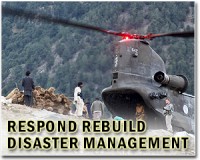| . |  |
. |
Otsuchi, Japan (AFP) April 9, 2011 Sachiko Miura had no warning before a huge tsunami slammed into the small Japanese fishing village where she has lived all her life -- because she could not hear the sirens. The first the hearing-impaired 66-year-old knew of the impending disaster was when she saw the massive wave bearing down on her small wooden house, less than an hour after the worst earthquake in Japan's recorded history. She spent an entire night cowering alone and terrified on the second floor of her home in the fishing village of Otsuchi on Japan's northeast coast. "In no time at all the water was up around my waist, and I was trembling with cold and fear," a tearful Miura recalled. "Once night fell I could see flames through the window and I felt explosions of gas or something. I don't want to remember it any more." Eventually, Miura was rescued by her neighbours and taken to a shelter, but even there she is struggling, unable to communicate properly with fellow survivors. Accessing information on food rations, benefit payments and arrangements for re-housing has proved particularly difficult without the special assistance she is used to. In all, 12,750 people have been confirmed dead and another 14,706 are still unaccounted for after the 9.0-magnitude quake and tsunami on March 11, the worst disaster Japan has faced since World War II. Around 160,000 people remain in shelters after either losing their homes or being evacuated due to fears of radiation from a stricken nuclear power plant. But for disabled Japanese living in the quake zone, the disaster has been particularly difficult. Many specialist care homes were destroyed, leaving residents to depend on fellow survivors who are themselves still traumatised by the disaster. "When Miura came to the shelter, she had trouble communicating with other people," said Chikako Yamazaki, a fellow survivor who has been ensuring the 66-year-old gets food and medical care in the shelter. "Everyone here is really stressed, they can't take care of other people," added Yamazaki. Takeo Yamada, 63, is partially paralysed and used to have a professional carer, but has been completely dependent on his wife since the couple were moved into a shelter after their home was destroyed. "It's so difficult," an emotional Yamada told AFP of life in the refuge. "I'm sorry for troubling my wife. I want to go back to our old way of life." Social worker Osamu Iwabuchi said many professional carers had been killed in the disaster, while others had left the quake zone. "It is difficult for us to get people back to work at the moment," he added. With thousands still on the missing list, authorities do not yet have a clear picture of how many disabled people are living in shelters. Officials in Iwate prefecture, one of the worst-hit by the disaster, put the number at at least 900, but neighbouring prefectures said they had no figures available. Social welfare expert Hiromitsu Mihara said communities needed to care for disabled survivors. But he said the shared ordeal could also bring disabled and able-bodied people closer together. "It is a good chance for disabled people to become more integrated into their local communities," said Mihara, professor of social welfare at the University of Hiroshima in western Japan. "I hope some good can come of this disaster."
Share This Article With Planet Earth
Related Links Bringing Order To A World Of Disasters A world of storm and tempest When the Earth Quakes
 BoJ warns on quake impact, offers loans
BoJ warns on quake impact, offers loansTokyo (AFP) April 7, 2011 The Bank of Japan on Thursday warned of the pressures on an economy reeling from its biggest recorded earthquake, a tsunami and nuclear crisis, and unveiled a lending scheme for banks in affected areas. It left its key rate unchanged at between zero and 0.1 percent and downgraded its view of the economy due to last month's disasters, which have plunged the nation into its worst crisis sinc ... read more |
|
| The content herein, unless otherwise known to be public domain, are Copyright 1995-2010 - SpaceDaily. AFP and UPI Wire Stories are copyright Agence France-Presse and United Press International. ESA Portal Reports are copyright European Space Agency. All NASA sourced material is public domain. Additional copyrights may apply in whole or part to other bona fide parties. Advertising does not imply endorsement,agreement or approval of any opinions, statements or information provided by SpaceDaily on any Web page published or hosted by SpaceDaily. Privacy Statement |